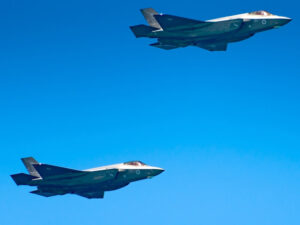The geographic realities of any potential future conflict all point to the overarching need for America and its global military partners to be able to control the airspace in any situation.
Strategic threats in the Indo-Pacific underscore the need to be able to project air power from the sea, while the ongoing conflict in Ukraine has demonstrated just how critical air superiority can be in a major land battle. For the United States, as well as many of our allies and strategic partners around the world, the F-35 Joint Strike Fighter is the primary vehicle by which this will be accomplished.
America’s 5th generation fighter aircraft contains the most advanced aeronautics, targeting and propulsion technology ever put into a single airframe and is expected to be the cutting-edge cornerstone of air strategy until at least the early 2030s. Therefore, it is imperative to keep the F-35 one step ahead of any potential threats. This includes performing necessary updates, such as engine upgrades.
Additional demands require engine boost for F-35
The Pratt & Whitney F135 engine and its thrust are critical parts of mission success. Developed from the F119 engine that powers the venerable F-22 Raptor, the F135 represents the latest in aircraft propulsion technology. But while the engine has met its originally assigned specifications, improvements to, and updated mission parameters for the F-35 over the last decade have placed additional demands on the F135 engine.
This has left the engine already running twice as hot as the design goal, and planners expect that the limitations of the Honeywell-supplied power and thermal management system (PTMS) on the engine will be exceeded by the end of the decade.
An update known as the Engine Core Upgrade (ECU) has been developed to solve these issues but there are those in Washington who are opposed to the ECU and prefer instead to fund a project known as the Adaptive Engine Transition Program (AETP). This would mean entirely replacing the F-35 engine with a new one built from scratch in the middle of the program, which would cause several issues.
To begin with, compatibility across the services would cease to exist. The AETP engine simply does not work with the Marine Corps F-35B Short-Take-Off-Vertical-Landing (STOVL) variant and would require substantial airframe modifications to fit in the F-35C variant used by the Navy. This would leave development of the AETP solely in the hands of the U.S. Air Force and create a time-wasting distraction from the prompt improvements the Navy and Marine Corps need, especially facing China.
As the engine would only be used in the F-35A Air Force variant, the Pentagon would also be required to create and maintain two separate maintenance and supply chains for the F-35. This would negate much of the interoperability that is a key feature of the Joint Strike Fighter. The reliable joint solution must prevail over the “gee whiz” massive change.
Cost would be excessive for second engine
Another concern is cost; the price tag for the AETP would be nearly $6.7 billion, and recently passed congressional caps on defense spending mean that there is only so much funding to go around. It makes little sense to divert that much money away from other priorities for a new engine when a far more cost-effective engine upgrade is readily available – one that will apply to all variants of the aircraft and meet or exceed all the enhanced requirements by increasing thrust and range by 10% and improving thermal management by 50%.
Air Force Secretary Frank Kendall took all of this into consideration when he decided earlier this year to pursue ECU over the AETP. But some in Congress appear to be second guessing his decision. The 2024 National Defense Authorization Act (NDAA) which recently passed the House of Representatives included nearly $600 million in funding for the AETP. Secretary Kendall reacted to this move by saying “As often happens, the Hill doesn’t want to let go.”
Such an expenditure would prove unwise at this time, but fortunately wiser heads have prevailed in the Senate. The upper chamber’s version of the NDAA fully funds the ECU and includes a specific prohibition against integrating any alternate engine, such as the AETP, on any F-35 variant. As negotiators from both chambers of Congress meet in Conference Committee to hash out differences between these two NDAA versions, let us support the Senate version so every defense dollar will be allocated to the maximum benefit.
The current national security threats facing America are ever evolving and our military capabilities must evolve with them or face the real possibility of falling behind and exposing our armed services to threats we cannot match. As defense dollars become increasingly scarce and the world becomes a more dangerous place, making smart investments in military capabilities will become increasingly important.
In this case, Congress should follow the lead of the Air Force and heed the advice of our warfighters on how to proceed with the F-35 engine upgrade.







